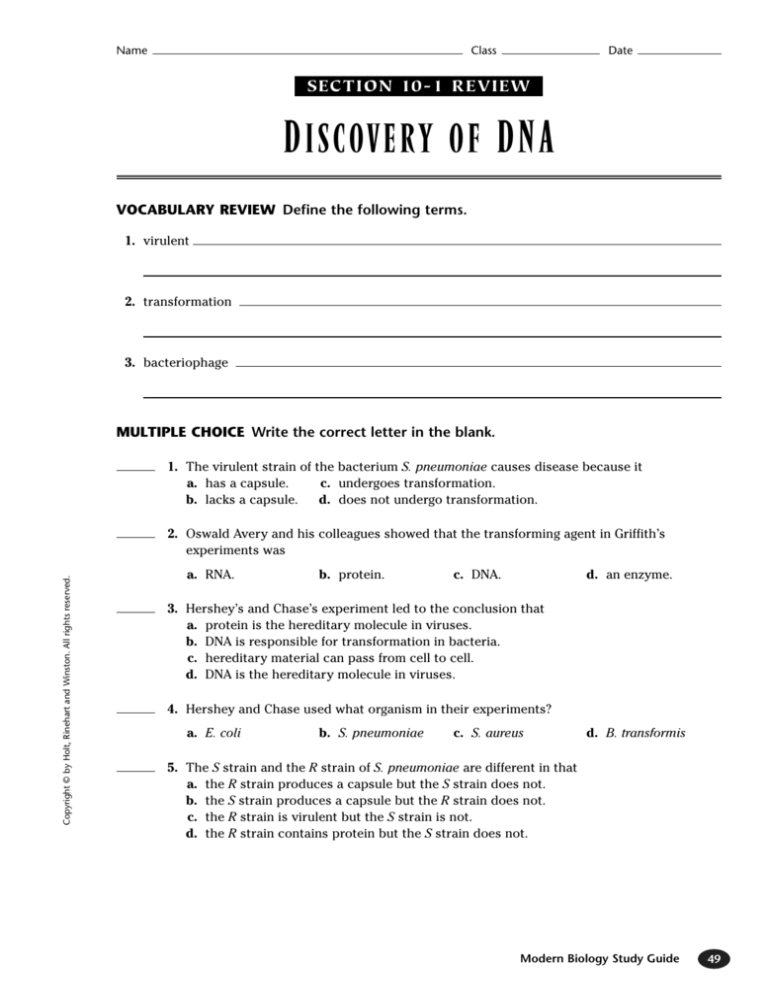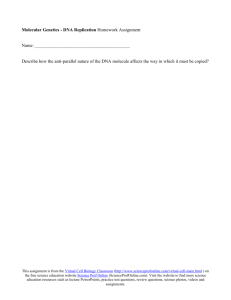
Name
Class
Date
SEC T I O N 10 - 1 R E VIEW
D ISCOVERY OF DNA
VOCABULARY REVIEW Define the following terms.
1. virulent
2. transformation
3. bacteriophage
MULTIPLE CHOICE Write the correct letter in the blank.
1. The virulent strain of the bacterium S. pneumoniae causes disease because it
a. has a capsule.
c. undergoes transformation.
b. lacks a capsule.
d. does not undergo transformation.
Copyright © by Holt, Rinehart and Winston. All rights reserved.
2. Oswald Avery and his colleagues showed that the transforming agent in Griffith’s
experiments was
a. RNA.
b. protein.
c. DNA.
d. an enzyme.
3. Hershey’s and Chase’s experiment led to the conclusion that
a. protein is the hereditary molecule in viruses.
b. DNA is responsible for transformation in bacteria.
c. hereditary material can pass from cell to cell.
d. DNA is the hereditary molecule in viruses.
4. Hershey and Chase used what organism in their experiments?
a. E. coli
b. S. pneumoniae
c. S. aureus
d. B. transformis
5. The S strain and the R strain of S. pneumoniae are different in that
a. the R strain produces a capsule but the S strain does not.
b. the S strain produces a capsule but the R strain does not.
c. the R strain is virulent but the S strain is not.
d. the R strain contains protein but the S strain does not.
Modern Biology Study Guide
49
Name
Class
Date
SHORT ANSWER Answer the questions in the space provided.
1. What was the purpose of Griffith’s experiment 1, in which he injected a mouse with live R cells?
2. What was the purpose of Griffith’s experiment 2, in which he injected a mouse with live S cells?
3. What was the purpose of Griffith’s experiment 3, in which he injected a mouse with heat-killed
S cells?
4. What was the purpose of Griffith’s experiment 4, in which he injected a mouse with a mixture of
heat-killed S cells and live R cells?
5. Critical Thinking Why is an S strain of bacteria able to cause disease in mammals but a R strain
is not?
Hershey-Chase’s Experiments
Experiment Number
Preparation
Action
Result
Experiment 1
radioactive sulfur
used to label protein
in phage
infect E. Coli with
sulfur-labeled phage
radioactive sulfur
did not enter
bacterial cell
Experiment 2
radioactive
phosphorous used to
label DNA in phage
infect E. Coli with
phosphorous-labeled
phage
radioactive
phosporous entered
bacterial cell
1. DNA is the hereditary material.
2. Protein is not the hereditary material.
50
Section 10-1 Review
Copyright © by Holt, Rinehart and Winston. All rights reserved.
STRUCTURES AND FUNCTIONS In the spaces provided, write the number of the
experiment that resulted in the following conclusions.
Name
Class
Date
SEC T I O N 10 - 2 R E VIEW
DNA S TRUCTURE
VOCABULARY REVIEW Define the following terms and provide one example for each.
1. purine
2. pyrimidine
3. complementary base pair
4. nitrogenous base
MULTIPLE CHOICE Write the correct letter in the blank.
Copyright © by Holt, Rinehart and Winston. All rights reserved.
1. The primary function of DNA in cells is to
a.
b.
c.
d.
serve as a storage form for unused nucleotides.
occupy space in the nucleus to keep the nucleus from collapsing.
store information that tells the cells which proteins to make.
serve as a template for making long, spiral carbohydrates.
2. The two strands of a DNA molecule are held together by
a. ionic bonds.
b. covalent bonds.
c. peptide bonds.
d. hydrogen bonds.
3. According to the base-pairing rules, guanine binds with
a. cytosine.
b. adenine.
c. thymine.
d. guanine.
4. Which of the following is NOT a correct structure of a nucleotide?
a. adenine—deoxyribose—phosphate
c. cytosine—deoxyribose—phosphate
b. adenine—ribose—phosphate
d. guanine—deoxyribose—phosphate
5. The percentage of adenine in DNA is
a. equal to the percentage of cytosine.
b. equal to the percentage of thymine.
c. not related to the percentage of thymine.
d. equal to the percentage of guanine.
Modern Biology Study Guide
51
Name
Class
Date
SHORT ANSWER Answer the questions in the space provided.
1. What are the three parts of a DNA nucleotide, and how are they connected to each other?
2. If 15% of the nucleotides in a DNA molecule contain guanine, what percentage of the nucleotides
contain each of the other three bases? Explain your reasoning.
3. Why is complementary base pairing important in DNA structure?
4. Critical Thinking How did X-ray diffraction photographs help Watson and Crick determine the
structure of DNA?
STRUCTURES AND FUNCTIONS Label each part of the figure in the spaces provided.
c
a
C
T
b
d
52
Section 10-2 Review
Copyright © by Holt, Rinehart and Winston. All rights reserved.
The diagram below shows two nucleotide base pairs in a segment of a DNA molecule.
Name
Class
Date
SEC T I O N 10 - 3 R E VIEW
DNA R EPLICATION
VOCABULARY REVIEW Define the following terms.
1. replication fork
2. helicase
3. semi-conservative replication
MULTIPLE CHOICE Write the correct letter in the blank.
1. Before replication can take place,
Copyright © by Holt, Rinehart and Winston. All rights reserved.
a.
b.
c.
d.
DNA polymerases must add complementary nucleotides to the DNA.
the two strands of DNA must separate.
the covalent bonds in DNA must break.
helicases must break the bonds in the nucleotides.
2. Replication of the two DNA strands takes place
a.
b.
c.
d.
in two different directions.
in the same direction of the replication fork.
in a direction opposite to that of the replication fork.
at right angles to the direction of the replication fork.
3. In replication in prokaryotes,
a.
b.
c.
d.
there are two origins.
two replication forks move in opposite directions.
replication proceeds in one direction.
there are no replication forks.
4. A mutation is a
a. change in the direction of a replication fork.
b. form of cancer.
c. kind of DNA replication.
d. change in the nucleotide sequence of DNA.
5. Which of the following enzymes is involved with breaking hydrogen bonds?
a. DNA polymerase
b. DNA ligase
c. DNA helicase
d. Both a and b
Modern Biology Study Guide
53
Name
Class
Date
SHORT ANSWER Answer the questions in the space provided.
1. How does replication occur so quickly in eukaryotes?
2. Why is it important that exact copies of DNA are produced during replication?
3. How is DNA replication related to cancer?
4. Critical Thinking Why is it advantageous to have weak hydrogen bonds between complementary
bases and strong covalent bonds between phosphate and deoxyribose groups in a DNA molecule?
STRUCTURES AND FUNCTIONS The figure below shows DNA replicating. In the space
provided, describe what is occurring at each lettered section of the figure.
Part a.
Part b.
Part c.
Copyright © by Holt, Rinehart and Winston. All rights reserved.
Part a.
Part b.
Part c.
54
Section 10-3 Review
SEC T I O N 10 - 4 R E VIEW
Name
Class
Date
SEC T I O N 10 - 4 R E VIEW
P ROTEIN S YNTHESIS
VOCABULARY REVIEW Define the following terms.
1. codon
2. translation
3. anticodon
MULTIPLE CHOICE Write the correct letter in the blank.
1. A protein is a polymer consisting of a specific sequence of
a. amino acids.
b. fatty acids.
c. RNA nucleotides.
d. DNA nucleotides.
Copyright © by Holt, Rinehart and Winston. All rights reserved.
2. The genetic code specifies the correlation between
a.
b.
c.
d.
a DNA-nucleotide sequence and an RNA-nucleotide sequence.
an mRNA-nucleotide sequence and a tRNA-nucleotide sequence.
an mRNA-nucleotide sequence and an rRNA-nucleotide sequence.
an RNA-nucleotide sequence and an amino-acid sequence.
3. During translation, one end of a tRNA molecule pairs with a complementary
a. nucleotide sequence in DNA.
b. mRNA codon.
c. tRNA molecule.
d. protein molecule.
4. In eukaryotic cells, RNA is copied from DNA in the
a. ribosomes.
b. nucleus.
c. nuclear membrane.
d. cytosol.
5. Two amino acids are linked by a peptide bond when
a.
b.
c.
d.
two ribosomes attach simultaneously to the same mRNA transcript.
two tRNAs pair with neighboring codons on an mRNA transcript.
two codons on an mRNA transcript bind to each other.
a ribosome attaches to two codons on an mRNA transcript.
Modern Biology Study Guide
55
Name
Class
Date
SHORT ANSWER Answer the questions in the space provided.
1. List, in order, the tRNA anticodons that are complementary to the mRNA sequence
AUGCAUGCAAGUUAG.
How many amino acids will be in the polypeptide that is initially formed when this mRNA
sequence is translated?
2. Explain why methionine is the first amino acid in every growing polypeptide.
3. Describe three ways that RNA differs from DNA.
4. Critical Thinking How would a deletion of one nucleotide in the middle of an mRNA transcript
affect the polypeptide specified by that transcript?
STRUCTURES AND FUNCTIONS Label each part of the figure in the spaces provided.
b
c
d
e
a
f
g
h
56
Section 10-4 Review
Copyright © by Holt, Rinehart and Winston. All rights reserved.
The diagram below summarizes the events that occur during translation.







